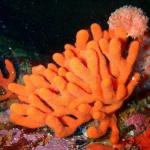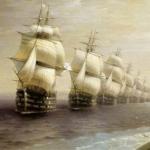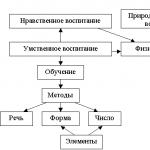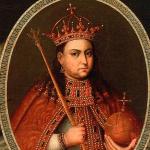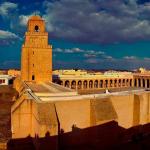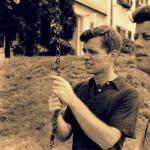Peter 1 when he was born and died. I Peter biography
Peter the Great was born in Moscow in 1672. His parents are Alexey Mikhailovich and Natalya Naryshkina. Peter was raised by nannies, his education was weak, but the boy’s health was strong, he was sick least of all in the family.
When Peter was ten years old, he and his brother Ivan were proclaimed kings. In fact, Sofya Alekseevna reigned. And Peter and his mother left for Preobrazhenskoye. There, little Peter began to become interested in military activities and shipbuilding.
In 1689, Peter I became king, and Sophia's reign was suspended.
During his reign, Peter created a powerful fleet. The ruler fought against Crimea. Peter went to Europe because he needed allies to help him stand against the Ottoman Empire. In Europe, Peter devoted a lot of time to shipbuilding and studying the cultures of different countries. The ruler mastered many crafts in Europe. One of them is gardening. Peter I brought tulips from Holland to the Russian Empire. The emperor liked to grow various plants brought from abroad in his gardens. Peter also brought rice and potatoes to Russia. In Europe, he became obsessed with the idea of changing his state.
Peter I waged war with Sweden. He annexed Kamchatka to Russia and the shores of the Caspian Sea. It was in this sea that Peter I baptized those close to him. Peter's reforms were innovative. During the Emperor's reign there were several military reforms, the power of the state increased, and a regular army and navy were founded. The ruler also invested his efforts in the economy and industry. Peter I invested a lot of effort in the education of citizens. Many schools were opened by them.
Peter I died in 1725. He was seriously ill. Peter handed the throne to his wife. He was a strong and persistent person. Peter I made many changes, both in the political system and in the life of the people. He successfully ruled the state for more than forty years.
Biography by dates and interesting facts. The most important.
Other biographies:
- Bazhov Pavel Petrovich
Pavel Petrovich Bazhov was born in 1879 near the city of Yekaterinburg. Pavel's father was a worker. As a child, Pavel often moved his family from place to place due to his father’s business trips.
- Mikhail Gorbachev
Mikhail Sergeevich Gorbachev was born on March 2, 1931 in the Stavropol village of Privolnoye. In his childhood he had to face the capture of Stavropol by the German fascists
Peter I was born on May 30, 1672, the 14th child of Alexei Mikhailovich, but the first-born of his wife, Natalya Kirillovna Naryshkina. Peter was baptized in the Chudov Monastery.
He ordered the measures to be removed from the newborn and an icon of the same size to be painted. Simon Ushakov painted an icon for the future emperor. On one side of the icon the face of the Apostle Peter was depicted, on the other the Trinity.
Natalya Naryshkina loved her firstborn very much and cherished him very much. The baby was entertained with rattles and harps, and he was drawn to toy soldiers and skates.
When Peter turned three years old, the Tsar Father gave him a children's sabre. At the end of 1676, Alexei Mikhailovich died. Peter's half-brother Fyodor ascends the throne. Fyodor was concerned that Peter was not being taught to read and write, and asked Naryshkina to devote more time to this component of training. A year later, Peter began to actively study.
He was assigned a clerk, Nikita Moiseevich Zotov, as his teacher. Zotov was a kind and patient man, he quickly fell into the good graces of Peter I, who did not like to sit still. He loved to climb in attics and fight with archers and noble children. Zotov brought good books to his student from the armory.
From early childhood, Peter I began to be interested in history, military art, geography, loved books and, already being Emperor of the Russian Empire, dreamed of compiling a book on the history of his fatherland; He himself composed the alphabet, which was easy on the tongue and easy to remember.
Tsar Fyodor Alekseevich died in 1682. He did not leave a will. After his death, only two brothers Peter I and Ivan could claim the throne. The paternal brothers had different mothers, representatives of different noble families. Having secured the support of the clergy, the Naryshkins elevated Peter I to the throne, and Natalya Kirillovna was made ruler. The relatives of Ivan and Princess Sophia, the Miloslavskys, were not going to put up with this state of affairs.
The Miloslavskys organize a Streltsy riot in Moscow. On May 15, a Streltsy uprising took place in Moscow. The Miloslavskys started a rumor that Tsarevich Ivan had been killed. Dissatisfied with this, the archers moved to the Kremlin. In the Kremlin, Natalya Kirillovna came out to them with Peter I and Ivan. Despite this, the archers rampaged in Moscow for several days, robbed and killed, they demanded that the feeble-minded Ivan be crowned king. And she became the regent of two young kings.
Ten-year-old Peter I witnessed the horrors of the Streltsy riot. He began to hate the Streltsy, who aroused in him rage, a desire to avenge the death of loved ones and the tears of his mother. During the reign of Sophia, Peter I and his mother lived almost all the time in Preobrazhenskoye, Kolomenskoye and Semenovskoye villages, only occasionally traveling to Moscow to participate in official receptions.
Natural curiosity, quickness of mind, and strength of character led Peter to a passion for military affairs. He arranges “war fun”. “War fun” is semi-childish games in palace villages. Forms amusing regiments, which recruit teenagers from noble and peasant families. “Military fun” eventually grew into real military exercises. Amusing regiments soon became adults. The Semenovsky and Preobrazhensky regiments became an impressive military force, superior to the Streltsy army in military affairs. In those same young years, Peter I came up with the idea of a fleet.
He gets acquainted with shipbuilding on the Yauza River, and then on Lake Pleshcheyeva. Foreigners living in the German Settlement played a large role in Peter’s military fun. The Swiss and Scotsman Patrick Gordon will have a special position in the military system of the Russian state under Peter I. Many like-minded people gather around young Peter, who will become his close associates in life.
He becomes close to Prince Romodanovsky, who fought with the archers; Fedor Apraksin - future admiral general; Alexei Menshikov, future field marshal of the Russian army. At the age of 17, Peter I married Evdokia Lopukhina. A year later, he cooled down to her and began to spend more time with Anna Mons, the daughter of a German merchant.
Coming of age and marriage gave Peter I full right to the royal throne. In August 1689, Sophia provoked a Streltsy uprising directed against Peter I. He took refuge in the Trinity - Sergeyev Lavra. Soon the Semenovsky and Preobrazhensky regiments approached the monastery. Patriarch of All Rus' Joachim also took his side. The mutiny of the Streltsy was suppressed, its leaders were subjected to repression. Sophia was imprisoned in the Novodevichy Convent, where she died in 1704. Prince Vasily Vasilyevich Golitsyn was sent into exile.
Peter I began to independently govern the state, and with the death of Ivan, in 1696, he became the sole ruler. At first, the sovereign took little part in state affairs; he was passionate about military affairs. The burden of governing the country fell on the shoulders of the mother's relatives - the Naryshkins. In 1695, the independent reign of Peter I began.
He was obsessed with the idea of access to the sea, and now the 30,000-strong Russian army, under the command of Sheremetyev, goes on a campaign against the Ottoman Empire. Peter I is an epoch-making personality, under him Russia became an Empire, and the Tsar became an Emperor. He pursued an active foreign and domestic policy. The priority of foreign policy was to gain access to the Black Sea. To achieve these goals, Russia participated in the Northern War.
In domestic policy, Peter I made many changes. He went down in Russian history as a reformer tsar. His reforms were timely, although they killed Russian identity. We managed to carry out transformations in trade and industry. Many praise the personality of Peter I, calling him the most successful ruler of Russia. But history has many faces; in the life of each historical character you can find both good and bad sides. Peter I died in 1725, in terrible agony after a long illness. He was buried in the Peter and Paul Cathedral. After him, his wife, Catherine I, sat on the throne.
Officially, the beginning of the reign of Peter I is usually counted from May 7, 1682, when, after the death of his brother Fyodor Alekseevich, he, at the age of ten, was crowned Tsar of All Rus' along with his fifteen-year-old brother Ivan V. In fact, the independent reign of Peter I began not even after the overthrow of Princess Regent Sophia in 1689, who had ruled during the dual reign since 1682, but only since the death of his mother, Natalya Naryshkina, in 1694.
Beginning of the reign of Peter I and Ivan V - coronation, 1682
Streletsky riot 1682 - Khovanshchina
After the death of Tsar Fedor, the Miloslavskys, with the help of I.A. Khovansky, directed the wrath of the archers against the Naryshkin clan, resulting in the throne along with Peter I was crowned by his brother Ivan V, A Princess Regent Sophia became the de facto ruler(daughter of the first wife of Tsar Alexei Mikhailovich - Maria Miloslavskaya).
The reign of Peter and Ivan - the reign of Princess Sophia
Sophia ruled based on her favorite - Vasily Golitsin. After concluding a fairly profitable “Eternal Peace” with Poland in 1686, it was Golitsin who launched two unsuccessful campaigns against the Crimean Khanate in 1687 and 1689. After the Albazin War with China for the Amur territories, the unfavorable Treaty of Nerchinsk of 1689 was concluded.
Removal of Sophia 1689
On May 30, 1689, Peter I turned 17 years old, he was married and, according to custom, no longer needed the regent princess Sophia. The princess did not want to give up power, and, according to rumors, was preparing an assassination attempt on the king. Together with his closest associates, and the amusing army representing at that time already combat-ready units, Peter I took refuge in the Trinity-Sergius Monastery. Gradually, Sophia lost power - most of her subjects and troops swore allegiance to Peter I, and the princess was exiled to a monastery.
 Tsarevna Sofya Alekseevna Romanova
Tsarevna Sofya Alekseevna Romanova
The first years of the reign of Peter I
After the overthrow of Princess Sophia in 1689, Ivan V actually ceased to participate in the reign - power passed into the hands of people who rallied around the mother of Peter I, Tsarina Natalya Kirillovna. She tried to accustom her son to public administration, entrusting him with private affairs, which Peter found boring. The most important decisions (declaration of war, election of the Patriarch, etc.) were made without taking into account the opinion of the young king. This led to conflicts. After the death of Natalya Kirillovna, the tsar did not displace the government of L.K. Naryshkin - B.A. Golitsyn, formed by his mother, but ensured that it strictly carried out his will.
 Natalia Naryshkina
Natalia Naryshkina
Azov campaigns
The death of the Tsar's mother, Natalya Kirillovna Naryshkina in 1694, marked the beginning of the independent reign of Peter I. His brother Ivan V, who lived until 1696, did not take part in the administration. Peter I wanted to test his new military formations in action - the Semenovsky and Preobrazhensky regiments; in addition, the Azov fortress was a key point for consolidation on the coast of the Azov Sea.
The first Azov campaign of 1695 ended in failure due to the poor organization of the Russian troops and lack of naval support, and Peter I learned his lesson - he went to build new shipyards and ships.
Having gathered more troops, with the support of artillery and the navy, which cut off the Turkish fortress from supplies by sea, Peter I took Azov during the second Azov campaign in 1696. Taganrog was founded as a base for the Russian fleet in 1698.
Intervention of Peter I in European politics
In an effort to prevent the election of a pro-French prince to the Polish throne, Peter I sent streltsy units under the command of G. Romodanovsky to the Lithuanian border to support the party of the Elector of Saxony, Friedrich Augustus, who was also fighting for the Polish crown. As a result, the plan was a success - the Elector ascended the Polish throne under the name of Augustus II and gave his word to act jointly against the Turks.
Great Embassy 1697-1698
The Azov campaigns clearly proved the importance of the fleet and artillery for warfare. Peter I understood that in technological terms the Russian kingdom was significantly behind the advanced Western states - he wanted to personally see the advanced technologies for the production of weapons and ships, and get acquainted with the traditions of Europe. In addition, it was necessary to find allies to wage wars against Turkey and Sweden for the right to gain access to the seas. This trip, undertaken by Peter I at the beginning of his reign, had a significant impact on the future fate of the tsar and radically changed cultural life in Russia.
Streltsy riot of 1698
The uprising of the Moscow archers during the stay of Peter I in the Great Embassy, with a total number of more than 2 thousand people, is justified by historians by the hardships of military campaigns, insufficient salaries and the appointment of foreign officers to senior military positions. Princess Sophia planned to take advantage of events and regain her lost power.
Peter I Alekseevich is the last Tsar of All Rus' and the first All-Russian Emperor, one of the most outstanding rulers of the Russian Empire. He was a true patriot of his state and did everything possible for its prosperity.
From his youth, Peter I showed great interest in various things, and was the first of the Russian tsars to make a long journey through European countries.
Thanks to this, he was able to accumulate a wealth of experience and carry out many important reforms that determined the direction of development in the 18th century.
In this article we will take a closer look at the characteristics of Peter the Great, and pay attention to his personality traits, as well as his successes in the political arena.
Biography of Peter 1
Peter 1 Alekseevich Romanov was born on May 30, 1672 in. His father, Alexei Mikhailovich, was the Tsar of the Russian Empire, and ruled it for 31 years.
Mother, Natalya Kirillovna Naryshkina, was the daughter of a small nobleman. Interestingly, Peter was the 14th son of his father and the first of his mother.
Childhood and youth of Peter I
When the future emperor was 4 years old, his father Alexei Mikhailovich died, and Peter’s older brother, Fyodor 3 Alekseevich, took the throne.
The new tsar began raising little Peter, ordering him to be taught various sciences. Since at that time there was a struggle against foreign influence, his teachers were Russian clerks who did not have deep knowledge.
As a result, the boy was unable to receive a proper education, and until the end of his days he wrote with errors.
However, it is worth noting that Peter 1 managed to compensate for the shortcomings of basic education with rich practical training. Moreover, the biography of Peter I is notable precisely for his fantastic practice, and not for his theory.
History of Peter 1
Six years later, Fedor 3 died, and his son Ivan was to ascend to the Russian throne. However, the legal heir turned out to be a very sick and weak child.
Taking advantage of this, the Naryshkin family, in fact, organized a coup d'etat. Having secured the support of Patriarch Joachim, the Naryshkins made young Peter king the very next day.
 26-year-old Peter I. The portrait by Kneller was presented by Peter in 1698 to the English king
26-year-old Peter I. The portrait by Kneller was presented by Peter in 1698 to the English king However, the Miloslavskys, relatives of Tsarevich Ivan, declared the illegality of such a transfer of power and the infringement of their own rights.
As a result, the famous Streletsky revolt took place in 1682, as a result of which two kings were on the throne at the same time - Ivan and Peter.
From that moment on, many significant events occurred in the biography of the young autocrat.
It is worth emphasizing here that from an early age the boy was interested in military affairs. On his orders, fortifications were built, and real military equipment was used in staged battles.
Peter 1 put uniforms on his peers and marched with them along the city streets. Interestingly, he himself acted as a drummer, walking in front of his regiment.
After the formation of his own artillery, the king created a small “fleet”. Even then he wanted to dominate the sea and lead his ships into battle.
Tsar Peter 1
As a teenager, Peter 1 was not yet able to fully govern the state, so his half-sister Sofya Alekseevna, and then his mother Natalya Naryshkina, became his regent.
In 1689, Tsar Ivan officially transferred all power to his brother, as a result of which Peter 1 became the only full-fledged head of state.

After the death of his mother, his relatives, the Naryshkins, helped him manage the empire. However, the autocrat soon freed himself from their influence and began to independently rule the empire.
Reign of Peter 1
From that time on, Peter 1 stopped playing war games, and instead began to develop real plans for future military campaigns. He continued to wage war in Crimea against the Ottoman Empire, and also repeatedly organized the Azov campaigns.
As a result of this, he managed to take the Azov fortress, which became one of the first military successes in his biography. Then Peter 1 began building the port of Taganrog, although there was still no fleet as such in the state.
From that time on, the emperor set out to create a strong fleet at all costs in order to have influence on the sea. To do this, he made sure that young nobles could study ship craft in European countries.
It is worth noting that Peter I himself also learned to build ships, working as an ordinary carpenter. Thanks to this, he gained great respect among ordinary people who watched him work for the good of Russia.
Even then, Peter the Great saw many shortcomings in the state system and was preparing for serious reforms that would forever inscribe his name in.
He studied the government structure of the largest European countries, trying to adopt the best from them.
During this period of biography, a conspiracy was drawn up against Peter 1, as a result of which a Streltsy uprising was supposed to occur. However, the king managed to suppress the rebellion in time and punish all the conspirators.
After a long confrontation with the Ottoman Empire, Peter the Great decided to sign a peace agreement with it. After that, he started a war with.
He managed to capture several fortresses at the mouth of the Neva River, on which the glorious city of Peter the Great would be built in the future.
Wars of Peter the Great
After a series of successful military campaigns, Peter 1 managed to open access to the Baltic Sea, which would later be called the “window to Europe.”
Meanwhile, the military power of the Russian Empire was constantly increasing, and the glory of Peter the Great spread throughout Europe. Soon the Eastern Baltic states were annexed to Russia.

In 1709, the famous battle took place, in which the Swedish and Russian armies fought. As a result, the Swedes were completely defeated, and the remnants of the troops were taken prisoner.
By the way, this battle was superbly described in the famous poem “Poltava”. Here's a snippet:
There was that troubled time
When Russia is young,
Straining strength in struggles,
She dated the genius of Peter.
It is worth noting that Peter 1 himself took part in battles, showing courage and bravery in battle. By his example, he inspired the Russian army, which was ready to fight for the emperor to the last drop of blood.
Studying Peter's relationship with the soldiers, one cannot help but recall the famous story about a careless soldier. Read more about this.
An interesting fact is that at the height of the Battle of Poltava, an enemy bullet shot through Peter I’s hat, passing just a few centimeters from his head. This once again proved the fact that the autocrat was not afraid to risk his life to defeat the enemy.
However, numerous military campaigns not only took the lives of valiant warriors, but also depleted the country's military resources. Things got to the point that the Russian Empire found itself in a situation where it was necessary to fight on 3 fronts simultaneously.
This forced Peter 1 to reconsider his views on foreign policy and make a number of important decisions.
He signed a peace agreement with the Turks, agreeing to give them back the fortress of Azov. By making such a sacrifice, he was able to save many human lives and military equipment.
After some time, Peter the Great began organizing campaigns to the east. Their result was the annexation of such cities as Semipalatinsk and to Russia.

Interestingly, he even wanted to organize military expeditions to North America and India, but these plans were never destined to come true.
But Peter the Great was able to brilliantly carry out the Caspian campaign against Persia, conquering Derbent, Astrabad and many fortresses.
After his death, most of the conquered territories were lost, since their maintenance was not profitable for the state.
Reforms of Peter 1
Throughout his biography, Peter 1 implemented many reforms aimed at the benefit of the state. Interestingly, he became the first Russian ruler who began to call himself emperor.
The most important reforms concerned military affairs. In addition, it was during the reign of Peter 1 that the church began to submit to the state, which had never happened before.

The reforms of Peter the Great contributed to the development of industry and trade, as well as a departure from an outdated way of life.
For example, he imposed a tax on wearing a beard, wanting to impose European standards of appearance on the boyars. And although this caused a wave of discontent on the part of the Russian nobility, they still obeyed all his decrees.
Every year, medical, maritime, engineering and other schools were opened in the country, in which not only the children of officials, but also ordinary peasants could study. Peter 1 introduced the new Julian calendar, which is still used today.
While in Europe, the king saw many beautiful paintings that captured his imagination. As a result, upon arriving home, he began to provide financial support to artists in order to stimulate the development of Russian culture.
To be fair, it must be said that Peter 1 was often criticized for the violent method of implementing these reforms. Essentially, he forced people to change their thinking and also to carry out the projects he had in mind.
One of the most striking examples of this is the construction of St. Petersburg, which was carried out under difficult conditions. Many people could not withstand such stress and ran away.
Then the families of the fugitives were put in prison and remained there until the culprits returned back to the construction site.
 Peter I
Peter I Soon Peter 1 formed a body of political investigation and court, which was transformed into the Secret Chancellery. Any person was prohibited from writing in closed rooms.
If anyone knew about such a violation and did not report it to the king, he was subject to the death penalty. Using such harsh methods, Peter tried to fight anti-government conspiracies.
Personal life of Peter 1
In his youth, Peter 1 loved to be in the German settlement, enjoying foreign society. It was there that he first saw the German Anna Mons, with whom he immediately fell in love.
His mother was against his relationship with a German woman, so she insisted that he marry Evdokia Lopukhina. An interesting fact is that Peter did not contradict his mother and took Lopukhina as his wife.
Of course, in this forced marriage, their family life could not be called happy. They had two boys: Alexey and Alexander, the latter of whom died in early childhood.
Alexei was to become the legal heir to the throne after Peter 1. However, due to the fact that Evdokia tried to overthrow her husband from the throne and transfer power to her son, everything turned out completely differently.
Lopukhina was imprisoned in a monastery, and Alexei had to flee abroad. It is worth noting that Alexei himself never approved of his father’s reforms, and even called him a despot.
 Peter I interrogates Tsarevich Alexei. Ge N. N., 1871
Peter I interrogates Tsarevich Alexei. Ge N. N., 1871 In 1717, Alexei was found and arrested, and then sentenced to death for participating in a conspiracy. However, he died in prison, and under very mysterious circumstances.
Having divorced his wife, in 1703 Peter the Great became interested in 19-year-old Katerina (nee Marta Samuilovna Skavronskaya). A whirlwind romance began between them, which lasted for many years.
Over time, they got married, but even before her marriage she gave birth to daughters Anna (1708) and Elizabeth (1709) from the emperor. Elizabeth later became empress (reigned 1741-1761)
Katerina was a very smart and insightful girl. She alone managed, with the help of affection and patience, to calm the king when he had acute attacks of headache.
 Peter I with the sign of the Order of St. Andrew the First-Called on a blue St. Andrew's ribbon and a star on his chest. J.-M. Nattier, 1717
Peter I with the sign of the Order of St. Andrew the First-Called on a blue St. Andrew's ribbon and a star on his chest. J.-M. Nattier, 1717 They officially got married only in 1712. After that, they had 9 more children, most of whom died at an early age.
Peter the Great truly loved Katerina. The Order of St. Catherine was established in her honor and the city of Yekaterinburg in the Urals was named. The Catherine Palace in Tsarskoye Selo (built under her daughter Elizaveta Petrovna) also bears the name of Catherine I.
Soon, another woman, Maria Cantemir, appeared in the biography of Peter 1, who remained the emperor’s favorite until the end of his life.
It is worth noting that Peter the Great was very tall - 203 cm. At that time, he was considered a real giant, and was head and shoulders taller than everyone else.
However, the size of his feet did not correspond to his height at all. The autocrat wore size 39 shoes and had very narrow shoulders. As an additional support, he always carried a cane with him on which he could lean.
Death of Peter
Despite the fact that outwardly Peter 1 seemed to be a very strong and healthy person, in fact he suffered from migraine attacks throughout his life.
In the last years of his life, he also began to suffer from kidney stones, which he tried to ignore.
At the beginning of 1725, the pain became so severe that he could no longer get out of bed. His health condition worsened every day, and his suffering became unbearable.
Peter 1 Alekseevich Romanov died on January 28, 1725 in the Winter Palace. The official cause of his death was pneumonia.
 The Bronze Horseman is a monument to Peter I on Senate Square in St. Petersburg
The Bronze Horseman is a monument to Peter I on Senate Square in St. Petersburg However, an autopsy showed that death was due to inflammation of the bladder, which soon developed into gangrene.
Peter the Great was buried in the Peter and Paul Fortress in St. Petersburg, and his wife Catherine 1 became the heir to the Russian throne.
If you liked the biography of Peter 1, share it on social networks. If you like biographies of great people in general, and in particular - subscribe to the site. It's always interesting with us!
Did you like the post? Press any button.
Peter I the Great (real name - Romanov Peter Alekseevich) - Russian Tsar, since 1721 - Emperor, an outstanding statesman, famous for a large number of cardinal reforms, commander - was born on June 9 (May 30, O.S.) in 1672 in Moscow; his father was Tsar Alexei Mikhailovich, his mother was Natalya Kirillovna Naryshkina.
The future emperor did not receive a systematic education, and although it is reported that his education began in 1677, in fact the boy was left largely to his own devices, spending most of his time with his peers in entertainment, in which he participated quite willingly. Until the age of 10, after the death of his father in 1676, Peter grew up under the supervision of Fyodor Alekseevich, his older brother. After his death, Ivan Alekseevich was supposed to become the heir to the throne, but the latter’s poor health contributed to the nomination of Peter to this post. Nevertheless, as a result of the Streltsy revolt, a political compromise was the enthronement of Peter and Ivan; Sofya Alekseevna, their elder sister, was appointed ruler.
During the period of Sophia's regency, Peter participated in government administration only formally, attending ceremonial events. Sophia, watching the grown-up Peter, who was seriously interested in military amusements, took measures to strengthen her power. In August 1689, Peter's supporters convened a noble militia, dealt with Sophia's main supporters, she herself was placed in a monastery, and after that power actually passed into the hands of Peter's party, Ivan remained only a nominal ruler.
Nevertheless, even after gaining real power, it was actually his mother and other close people who ruled instead of Peter. At first, after the death of Natalya Kirillovna in 1694, the state machine worked by inertia, so Peter, although he was forced to govern the country, entrusted this mission mainly to the ministers. He had become accustomed to detachment from affairs over many years of forced isolation from power.
At that time, Russia was very far from advanced European states in its socio-economic development. Peter's inquisitiveness, his ebullient energy, and keen interest in everything new allowed him to take on the most important issues in the life of the country, especially since life itself urgently pushed him towards this. The first victory in the biography of young Peter as a ruler was the second campaign against Azov in 1696, and this greatly contributed to the strengthening of his authority as a sovereign.
In 1697, Peter and his entourage went abroad, living in Holland, Saxony, England, Venice, Austria, where he became acquainted with the achievements of these countries in the field of technology, shipbuilding, as well as with the way of life of other countries of the continent, their political and social structure. The news of the Streltsy revolt that broke out in his homeland forced him to return to his homeland, where he suppressed the act of disobedience with extreme cruelty.
During his stay abroad, the tsar’s program in political life was formed. In the state, he saw the common good, which everyone, first of all, himself, had to serve, and set an example for others. Peter behaved in many ways unconventionally for a monarch, destroying his sacred image that had developed over the centuries, so a certain part of society was critical of him and his activities. Nevertheless, Peter I led the country along the path of radical reforms in all areas of life, from public administration to culture. They began with an order to shave their beards and wear clothes in a foreign style.
A number of reforms were undertaken in the public administration system. Thus, under Peter I, the Senate and collegiums were created; he subordinated the church to the state and introduced an administrative-territorial division of the country into provinces. In 1703, at the mouth of the Neva River, he founded the new Russian capital - St. Petersburg. They assigned a special mission to this city - it was to become a model city, a “paradise”. During the same period, instead of the boyar duma, a council of ministers appeared, and a lot of new institutions arose in St. Petersburg. When the Northern War ended, Russia received the status of an empire in 1721, and Peter was named “Great” and “Father of the Fatherland” by the Senate.
Much had changed in the economic system, since Peter was well aware of how deep the gulf was between the country he led and Europe. He took many measures to develop industry and trade, including foreign trade; under him, a large number of new industrial sectors, factories and factories, manufactories, shipyards, and marinas appeared. All this was created taking into account the adopted Western European experience.
Peter I was credited with creating a regular army and navy. The foreign policy pursued by him was extremely energetic; Peter the Great undertook many military campaigns. In particular, as a result of the Northern War (1700-1721), territories that Sweden had conquered earlier were annexed to Russia; after the war with Turkey, Russia received Azov.
During the reign of Peter, Russian culture was replenished with a large number of European elements. At this time, the Academy of Sciences was opened, many secular educational institutions were opened, and the first Russian newspaper appeared. Through the efforts of Peter, the career advancement of the noble class was made dependent on the level of their education. Under Peter I, the civil alphabet was adopted and New Year celebrations were introduced. A fundamentally new urban environment was being formed in St. Petersburg, starting with previously unbuilt architectural structures and ending with the forms of people’s pastime (in particular, Peter introduced the so-called assemblies by decree).
Peter I is credited with bringing Russia onto the international stage as a great power. The country has become a full-fledged participant in international relations, its foreign policy has become active and led to the strengthening of its authority in the world. For many, the Russian emperor himself turned into an exemplary reformer sovereign. For a long time, the management system he introduced and the principles of the territorial division of Russia were preserved; they laid the foundations of national culture. At the same time, Peter's reforms were contradictory, which created the preconditions for a crisis to brew. The ambiguity of the course he pursues is associated with violence as the main instrument of reform, the lack of changes in the social sphere, and the strengthening of the institution of serfdom.
Peter I the Great left behind an extensive manuscript heritage, numbering more than a dozen volumes; the emperor's relatives, acquaintances, his contemporaries, and biographers recorded many of the sovereign's statements that have survived to our time. On February 8 (January 28, O.S.), 1725, Peter I died in his brainchild, St. Petersburg. It is known that he suffered from a number of serious illnesses, which significantly brought his death closer.
